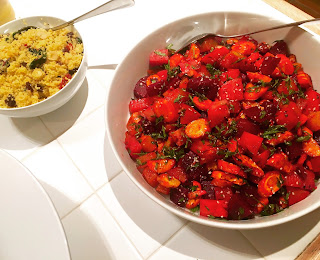 |
| "Heartbeet" salad for a client's Valentine's dinner party |
And beets are having a moment. In the 20th century, this would have confounded me. I was, seemingly, a born beet-hater, notorious for my acrobatic skills and back bends to avoid having pureed beets spoon-fed to me from the time I was a wee baby. As a child, I knew beets mostly in borscht form in Jewish delis, and as the coloring agent in the horseradish that accompanied my father's beloved (and to me, gag-inducing) matjes herring. It was all very eastern European old-school. In the interim, however, I've grown to adore beets, and like to play with their flavor and texture as much as I love using their bright color to make gorgeous plates of food, fuchsia dressings, and aiolis and sauces. The beets greens are delicious too -- which really speaks to my adoration of whole-vegetable cooking.
The rich, wine-dark magenta of many beets (they come in other brilliant colors and patterns, of course), are a perfect late winter vegetable: a root veggie to brighten cold weather cooking, which can get heavy...and a gorgeous color that speaks to the love and romance of February's romantic holiday: Valentine's Day. That these veggies are actually good for your heart is just the icing on the (healthy) cake.
So first, some history. The wild beet, the ancestor of the beet with which we're familiar today, is thought to have originated in prehistoric times in North Africa, and grew wild along Asian and European seashores. In these earlier times, people exclusively ate the beet greens and not the roots. The ancient Romans were actually one of the first civilizations to cultivate beets to use their roots as food. (You have to love the ancient Romans). The tribes that invaded Rome were responsible for spreading beets throughout northern Europe where they were first used for animal fodder, and later for human consumption, becoming more popular in the 16th century.
Beets' value grew in the 19th century when it was discovered that they were a concentrated source of sugar, and the first beet sugar factory was built in Poland at that time. And when access to sugar cane was restricted by the British, Napoleon decreed that the beet be used as the primary source of sugar, catalyzing its popularity even further. Around this same time, beets were first brought to the United States, where they now also flourish. Today the leading commercial producers of beets include the United States, Russia, France, Poland, and Germany.
As for the nutritional benefits of beets, preliminary research shows beetroot juice to reduce blood pressure in hypertensive individuals and so it may have an effect on mechanisms of cardiovascular disease. Beets are a unique source of phytonutrients called betalains. Betanin and vulgaxanthin are the two best-studied betalains derived from beets, and both have been shown to provide antioxidant, anti-inflammatory, and detoxification support -- which make beets a good source for likely risk reduction of many types of cancer, including colon, stomach, nerve, lung, breast, prostate, and testicular cancers. Even well before current-day scientific evidence, those living in the middle ages knew something was special about beets: back then, beetroot was used as a treatment for a variety of conditions, especially illnesses relating to digestion and the blood.
More good news: beets belong to the chenopod family — along with chard, spinach and quinoa — which continue to show an increasing number of health benefits not readily available from other food families. The red and yellow betalain pigments found in chenopods, their unique epoxyxanthophyll carotenoids, and the special connection between their overall phytonutrients and our nervous system health (including specialized nervous system organs like the eyes), point to a unique health value in beets.
I often speak about the connection between color and nutrition: the more colorful your plate, the better-balanced your nutritional intake will be. And we also eat with our eyes, so what better way to have a gorgeous, healthful meal than to "eat the rainbow" as it were? Beets help in bringing bright colors and their inherent vitamins, minerals, and antioxidants to the plate. Beets can range in color from pure white to golden to deep, dark burgundy. This dish pictured is a Moroccan-spiced salad of beets and carrots that have been roasted, peeled, and cubed. I used the carrot and beet greens to make a pesto to serve along the outer rim of the plated salad. This is an elegant appetizer, vegetarian-friendly, and nutritious and delicious. It checks all the boxes!
Chioggia beets, or "candycane" beets as they're nicknamed, are amazing, with concentric circles visible as you slice through them, in brilliant crimson and white or pink. The liquid you get from cooking beets or marinating beets can be used to make countless beautifully-colored sauces and dishes. It's the great base for a magenta vinaigrette, and it makes one gorgeous pink aioli just perfect for a romantic Valentine's Day meal. You can still make that electric-colored borscht, which when updated seems very modern and in line with the popularity of Eastern and Northern European foods. You can still pickle eggs in the briny beet juice, which makes for very pretty deviled eggs.
As a vegan-friendly substitute to beef tartare, I often do a beet tartare, which is meaty and earthy and delicious. A beet-tahini dip served with crudite is also a great party hors d'oeuvre. And around Hanukkah, and in fact year round, an interesting version of potato latkes is the beet-and-carrot latke. And since veggie juicing has become so popular, and beets-and-vodka are a natural Eastern European pairing, you can even make your cocktails healthy: beautiful, vibrant beetini anyone?
Beets are so versatile! You're really limited only by your own imagination...
Happy and healthy Valentine's Day, everyone! xoxo














No comments:
Post a Comment